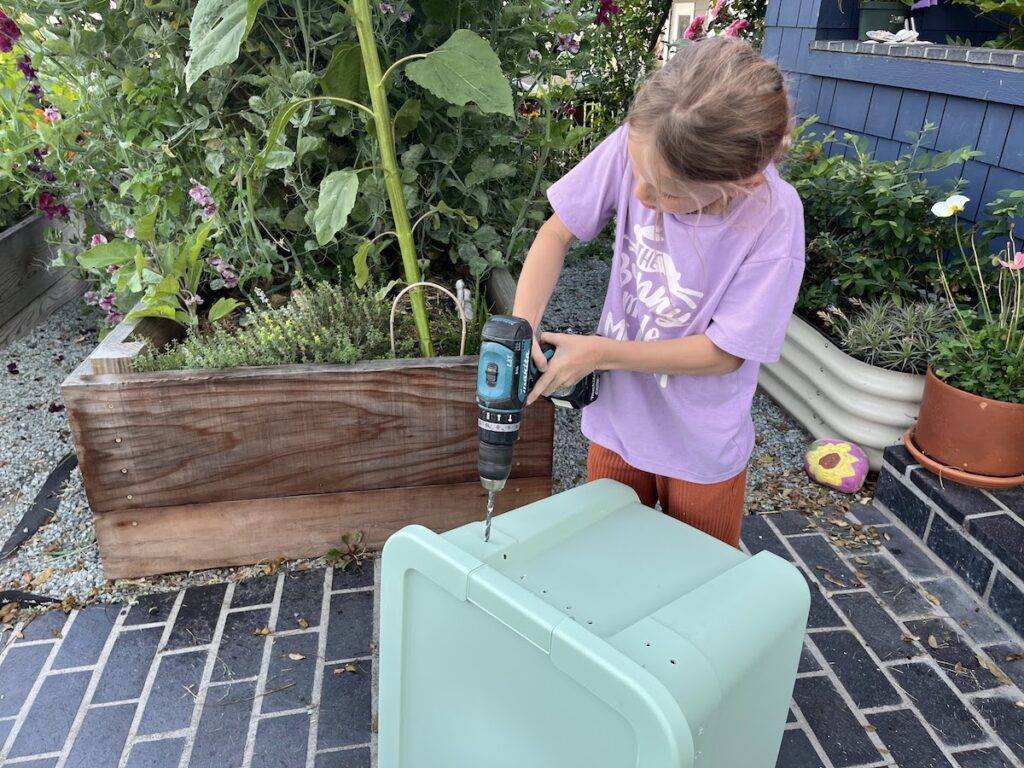Follow this step-by-step guide to raising worms that will make a sustainable fertilizer with your kitchen scraps.
Supplies:
- Worms, about a pound (Walter Anderson’s Nursery sells a bag of worms.)
- 15-35 gallon non-transparent Tupperware bin with lid (Reuse an old storage bin!)
- Drill and 1/4 in drill bit
- Bedding Material (This is your brown carbon source and is needed to balance out the food scraps and worm castings.)
- Shredded newspaper
- A few cups of potting soil
- Browns: rehydrated coco coir (coconut husk) or a few handfuls of dried leaves or garden straw
- Sheet of newspaper or cardboard to cover the inside contents and keep the worms from trying to escape. (You can just do this for the first couple of weeks to help them acclimate to their new home.)

Steps:
- Drill holes all around the top portion of your container about an inch apart. Do not drill holes in the lid or rain will get in and cause too much moisture. Do not drill holes in the bottom or the worms will escape!
- Add shredded newspaper to the container until it’s about 1/3 to 1/2 full. Add a few cups of potting or native soil. The soil will provide grit and tiny rocks/sand, which the worms need for their digestive tract. Add a few handfuls of rehydrated coco coir, dried leaves, or garden straw. Mix everything together. If you use rehydrated coco coir make sure to squeeze out the excess water.
- The material should be damp and not sopping wet. If needed, lightly mist the mixed bedding so it is damp.
- Dig a hole in the bedding and add your worms and a handful of food scraps (see below). Cover with bedding and a piece of newspaper or cardboard.
- Feed the worms weekly. A worm can eat its body weight in one day, so they are fast at composting your food waste! When feeding, dig a hole and add a handful of food scraps from your kitchen compost bin. Make sure to bury the food. At the next feeding place the food in a different location. This will force your worms to move around the bin. If you notice at your weekly feed there is food left over, decrease the amount of food until you find the right balance.
- Every few weeks, add a handful of bedding or browns to the bin to help with moisture control, even out the nitrogen, and help prevent a smelly bin.
- Once there is a good amount of worm castings (poop, but really looks like super rich soil), separate out a portion of the castings and use it in your garden as fertilizer. It's okay if a few worms are left in the castings. They will enrich your garden soil and your worm bin will continue to multiply with worm babies.
What do I feed my worms?
Food Worms Like:
- Shredded newspaper (bedding)
- Fruit
- Cereal
- Banana peels
- Vegetables
- Eggshells
- Coffee grounds
- Bread
- Brown leaves
Food Worms Don’t Like:
- Cheese
- Meat
- Eggs (just the shells can be composted)
- Plastic
- Food stickers
- Bone
If you have children you want to help out (and learn!), here are some other kid-friendly garden activities.


